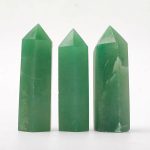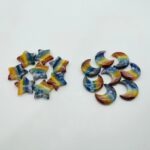In today’s market, differentiating between authentic and imitation crystals has become increasingly challenging. This guide will equip you with the knowledge and techniques to discern real crystals from their counterfeits.

Physical Characteristics
1. Hardness: Crystals possess distinct hardness values. Use a Mohs hardness scale (1-10) to determine the hardness of the crystal. Real crystals will generally have a hardness of 7 or higher.
2. Weight: Crystals are typically denser than glass or plastic imitations. Hold the crystal in your hand and feel its weight. Real crystals will feel heavier for their size.
3. Clarity: Natural crystals often contain inclusions or imperfections. While some imitations may have simulated inclusions, they will typically appear unnatural or repetitive.
4. Shape: Crystals form in specific crystalline structures. Note the crystal’s shape, symmetry, and angles. Real crystals will exhibit precise and geometrically consistent shapes.
Optical Properties
5. Refraction: Crystals bend light as it passes through them. Look for a refractive index of 1.5 or higher to indicate authenticity.
6. Double Refraction: Certain crystals, such as calcite, exhibit double refraction, splitting light into two distinct rays.
7. Dichroism: Some crystals show different colors when viewed from different angles. This property is known as dichroism and is a key indicator of genuine crystals.
Feel and Frequency
8. Tactile Perception: Real crystals can impart a subtle feeling of warmth or vibration when held. This is attributed to their energy field.
9. Energy Vibrations: Crystals resonate with specific energy frequencies. Using a pendulum or dowsing rods, you can detect the subtle vibrations emitted by genuine crystals.
Professional Authentication
10. Gemological Institute of America (GIA): GIA provides certification for gemstones and crystals, including identification and grading.
11. American Gem Society (AGS): AGS also offers certification and grading services for precious and semi-precious stones, including crystals.
Additional Tips and Tricks
- Use a magnifying glass to examine the crystal’s surface for scratches or imperfections.
- Conduct a scratch test on a small, inconspicuous area of the crystal. Real crystals will resist scratching from a sharp object.
- Consult with reputable crystal dealers or healers to obtain genuine crystals.
Counterfeit Crystals: Beware
- Inspect for signs of polishing, cutting, or molding.
- Beware of crystals with unnatural colors or perfect clarity.
- Avoid crystals with excessively high price tags.
Ethical Considerations
- Ensure that the crystals you purchase are ethically sourced and conflict-free.
- Support sustainable practices that preserve the integrity of crystal ecosystems.
Conclusion
Identifying real crystals requires a combination of scientific analysis, intuitive perception, and ethical consideration. By following these guidelines, you can confidently distinguish authentic crystals from their imitations and harness their unique energy and beauty.
| Property | Real Crystals | Counterfeit Crystals |
|---|---|---|
| Hardness | ≥7 on Mohs scale | <7 on Mohs scale |
| Weight | Denser | Lighter |
| Clarity | May contain inclusions | Usually clear or with simulated inclusions |
| Shape | Precise and geometric | Irregular or molded |
| Property | Real Crystals | Counterfeit Crystals |
|---|---|---|
| Refractive Index | ≥1.5 | <1.5 |
| Double Refraction | May exhibit | No double refraction |
| Dichroism | May show different colors | Uniform color |
| Property | Real Crystals | Counterfeit Crystals |
|---|---|---|
| Tactile Perception | Warm or vibrating | No noticeable feeling |
| Energy Vibrations | Resonate with specific frequencies | No detectable vibrations |
| Pain Point | Motivation | Solution |
|---|---|---|
| Misidentification of imitation crystals | Desire for genuine crystals | Using reliable identification techniques |
| Confusion about crystal healing | Need for informed decision-making | Consulting with reputable professionals or healers |
| Unscrupulous practices in the crystal industry | Ethical concerns | Supporting sustainable and conflict-free sources |




























